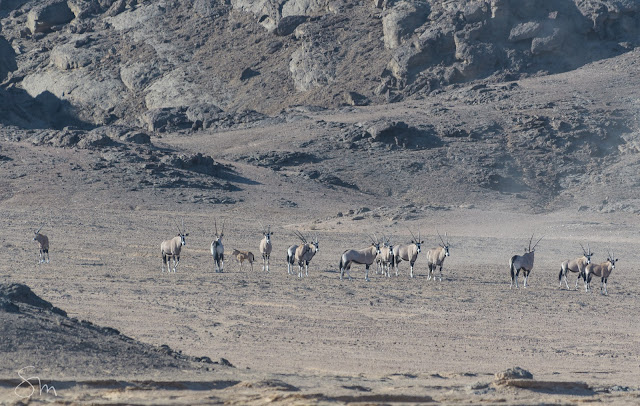The most impressive and varied landscape on our Namibia trip we encountered at Hoanib Skeleton Coast Camp where we stayed for three days. It sits in a stark, seemingly supernatural area, dry rough mountains, barren sand dunes, hostile desert plants, and all next to the dry riverbed of the Hoanib. The tents look like giant spiky insects crawling across an extraterrestial surface. Tents are very comfortable though and have spectacular views across the plains to the far distance.
One might think an open pool is a luxury quite superfluous on a safari in the remotest parts of Africa. However, they are compulsory elements of a settlement in the desert: they make up for the lack of water. In case of fire they substitute for the fire pond.
Early morning visitors in front of the tent
a springbok mum talking a stroll with kid and jackal
The scenery is spectacular and unforgettable
Impressions are continuously changing with the light, from clear sunny spells, to sand storms, day-in-day-out a view in fine monochromes of greyish brown.
Sand storms

In this barren, hostile area animal life was much more than we had expected. Apart from springbok and many oryx we saw groups of small toughened desert elephant, desert lion, brown hyenas and many giraffe.
Some giraffe and most lions are "tagged", carry transmitters for research purposes done by the Giraffe Conservation Foundation and the Desert Lion Conservancy Project and - in the case of the vanishing desert lion population - to provide an early-warning-system to avoid conflict with human settlements.
this beautiful mother as a small radio transmitter attached to one of her horns
In these harsh conditions with such a scarcity of food desert elephants are much smaller than their African relatives from the fertile plains of East Africa. Their families are smaller, too; large groups cannot be sustained.
this youngster is playing slide in the sand-pit
resting
We were very lucky to observe a lion hunt of two lionesses chasing oryx, starting from the outset, hiding in a perfect location, the stalking, the chase, the unfortunate failure and what looked like a short discussion or follow-up briefing afterwards.
We found a lioness "the Niece" on the slope of a small hill apparently watching something -
a group of oryx in the distance of the valley
a second lioness - "the Aunt" - was crouching low, hiding and biding her time. Between those two lionesses was a narrow valley where the group of oryx might pass through on their way to a water hole. Both are collared animals and known to our guide, aunt and niece hunting together.
the niece, moving closer
She was waiting for the herd of oryx to pass by close enough and was apparently looking for a small young oryx for lunch. Oryxes are very dangerous animals to hunt; one wrong movement and the lion can be had on a spit.
getting up and starting the chase
her first aim was the little baby oryx
but mothers are protective and dangerous
and oryxes are very fast animals
They got away ...
... and she is giving up , falling into a leisurely walk, pretending not to care... but what is this oryx doing there returning to face the lioness?
Should I be afraid of the oryx? Where is my aunt? Why isn't she helping me?
...doubidoubidou.... I don't care.... why should I worry about an oryx, I mean no harm... or should I worry?
Hm, maybe I should worry?
Cutting off her path
Turning tables .. the oryx is coming close ... the lioness decides to turn around ...
... and the strong oryx follows her for a bit making sure she does not even think of returning....
The herd is watching the stand-off from the safe distance.
the aunt is coming out of hiding and joining her niece on her retreat
dont worry, next time you will succeed.
a resting place for the evening
Another adventure was a long day on the ocean in the Skeleton Coast National Park. The Atlantic Ocean is only 70 km away from the Camp. In rural Africa and the rest of Namibia this might mean a few hours drive along rough tracks - here it means a six hour drive along no tracks. Sandstorms happen so frequently that tracks often last no longer than a few hours and have to be carved into the sand anew each time a group makes the trip to the coast.
An animal ( a jackal?) crossed the plains after the last waters flowed several years ago.
an oasis in the desert
On the coast!
a jackal among the seals
He got away with something - a pup?
More animals arrive to share his meal.
The skeleton coast has its name from the many ship wrecks and the poor seafarers who were washed upon the shore and had to starve and die of thirst in the dry barren desert bordering the beach.
The cold Benguela Stream from Antartica with its extreme currents and winds makes sure there is always plenty of fish. The last shipwreck was a Japanese trawler fishing illegally on the rich coast. It was abandoned in March 2018 when it had run aground.
Tracks of another predator on the coast, beach-roaming lions!
The airport of the camp
Returning to camp was by plane and quite quick as a sand storm was coming up again . You can see it in the back passing by.
Nightly view from the tent towards the Milky Way.








































































































